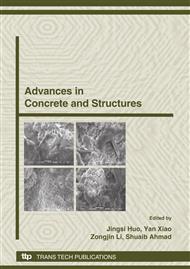[1]
Z.P. Bazant: Size effect, International Journal of Solids and Structures 37 (2000) : 69-80.
Google Scholar
[2]
W. Weibull: The phenomenon of rupture in solids. In: Proc., Royal Swedish Institute of Engineering Rearch, vol. 4 (1939), p.153, 1-55.
Google Scholar
[3]
W. Weibull: A statistical representation of fatigue failures in solids. Proc., Royal Swedish Institute of Engineering Rearch (1949), pp.1-27.
Google Scholar
[4]
W. Weibull: A statistical distribution function of wide applicability.: Jounal of Applied Mechanics ASME 18. (1951).
Google Scholar
[5]
Z.P. Bazant: Size effect aspects of measurement of fracture characteristics of quasibrittle material, Advanced Cement Based Materials, Volume 4, Issues 3-4 (1996), pp.128-137.
DOI: 10.1016/s1065-7355(96)00037-5
Google Scholar
[6]
Z.P. Bazant: Scaling of quasibrittle fracture: asymptotic analysis. International Journal of Fracture; vol. 83(1997), pp.19-40.
Google Scholar
[7]
Z.P. Bazant: Concrete fracture models: testing and practice, Engineering Fracture Mechanics, Volume 69, Issue 2, (2002), pp.165-205.
DOI: 10.1016/s0013-7944(01)00084-4
Google Scholar
[8]
Z.P. Bazant, Emilie Becq-Giraudon: Statistical prediction of fracture parameters of concrete and implications for choice of testing standard, Cement and Concrete Research, Volume 32, Issue 4, (2002), pp.529-556.
DOI: 10.1016/s0008-8846(01)00723-2
Google Scholar
[9]
Z.P. Bazant, Arash Yavari: Is the cause of size effect on structural strength fractal or energetic-statistical?, Engineering Fracture Mechanics, Volume 72, Issue 1 (2005), 1-31.
DOI: 10.1016/j.engfracmech.2004.03.004
Google Scholar
[10]
Giovanni Di Luzio, Z.P. Bazant: Spectral analysis of localization in nonlocal and over-nonlocal materials with softening plasticity or damage, International Journal of Solids and Structures, Volume 42, Issue 23 (2005), pp.6071-6100.
DOI: 10.1016/j.ijsolstr.2005.03.038
Google Scholar
[11]
A. Carpinteri, Chiaia B, Ferro G.: Multifractal scaling law for the nominal strength variation of concrete structures. In: Mihashi M, Okamura H., Z.P. Bazant, editors. Size e. ect in concrete structures. London, New York: E&FN Spon (1994).
Google Scholar
[12]
A. Carpinteri, Marco Paggi: Size-scale effects on the friction coefficient, International Journal of Solids and Structures, Volume 42, Issues 9-10 (2005), pp.2901-2910.
DOI: 10.1016/j.ijsolstr.2004.10.001
Google Scholar
[13]
A. Carpinteri, P. Cornetti: Size effect upon grained materials tensile strength: The increase of the statistical dispersion at the smaller scales, Theoretical and Applied Fracture Mechanics, Volume 44, Issue 2 (2005), pp.192-199.
DOI: 10.1016/j.tafmec.2005.06.008
Google Scholar
[14]
A. Carpinteri, Nicola Pugno: Cracks and re-entrant corners in functionally graded materials, Engineering Fracture Mechanics, Volume 73, Issue 10 (2006), pp.1279-1291.
DOI: 10.1016/j.engfracmech.2006.01.008
Google Scholar
[15]
A. Carpinteri, Simone Puzzi: A fractal approach to indentation size effect, Engineering Fracture Mechanics, Volume 73, Issue 15 (2006), pp.2110-2122.
DOI: 10.1016/j.engfracmech.2006.04.020
Google Scholar
[16]
Griffith, A.A., 1921, The phenomena of rupture and in solids. Phi. Trans. 221A, 179-180.
Google Scholar
[17]
J. R. del Viso, J. R. Carmona: Shape and size effect on the compressive strength of high-strength concrete, Cement and Concrete Rearch, vol. 38 (2008), pp.386-395.
DOI: 10.1016/j.cemconres.2007.09.020
Google Scholar
[18]
T. Krauthammer, M. M. Elfahal: Size effct for high-strength concrete cylinders subjected to axial impact, International Journal of Impact Engineering, vol. 28(2003), pp.1001-1016.
DOI: 10.1016/s0734-743x(02)00166-5
Google Scholar
[19]
Li Jiakang: Size effect for high-strength concrete cubes subjected to axial loads, Journal of building materials, vol 17 No. 1 (2004), pp.81-84(In Chinese).
Google Scholar
[20]
Qian Jueshi, Yang Zaifu: Experimental study in the size effect of high-strength concrete. Journal of HUST, vol 21 No. 1, (2004), pp.1-4. (In Chinese).
Google Scholar


